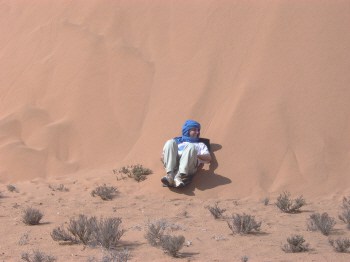From Marco Polo onwards explorers have told stories about strange sounds they have heard in the desert. It is known that the sounds are produced by sand dunes when they avalanche, but the exact mechanism behind the phenomenon has remained a mystery. Now, Bruno Andreotti from the University of Paris-7 has proposed that the sounds come from vibrations in the sand bed that have been excited by collisions between grains of sand (Phys. Rev. Lett. 93 238001).

“Singing dunes are one of the most puzzling and impressive natural phenomena I have ever encountered,” says Andreotti. “The sounds produced can be heard up to 10 kilometres away and resemble a drum or a low-flying jet.” The sounds can be as loud as 105 decibels and have frequencies between about 95 and 105 Hertz.
The French physicist took his equipment from Paris to the Atlantic Sahara in Morocco, which contains more than 10,000 crescent shaped dunes known as barchans. The wind in the desert can erode the back of these dunes, causing sand to build up at the top of the dune. When too much sand has accumulated, an avalanche occurs and the dunes start to “sing”.
Andreotti simultaneously measured vibrations in the sand bed and acoustic emissions in the air, and then extracted information about the frequency, amplitude and the phase of these signals. He found that the vibrations in the sand behaved like slow-moving elastic sound waves that were localized at the surface of the dune and had an amplitude that was about a quarter of the diameter of an individual grain of sand.
“The sounds result from avalanches in which the grains drum on one another, exciting elastic waves on the dune surface, with the vibration of the sand bed tending to synchronise the collisions,” he told PhysicsWeb. “In many ways the surface of the sand bed acts like the membrane in a loudspeaker.”
Andreotti now plans to study the effect in more detail in the laboratory and with computer simulations. The results could also be relevant to the behaviour of granular materials in general.



